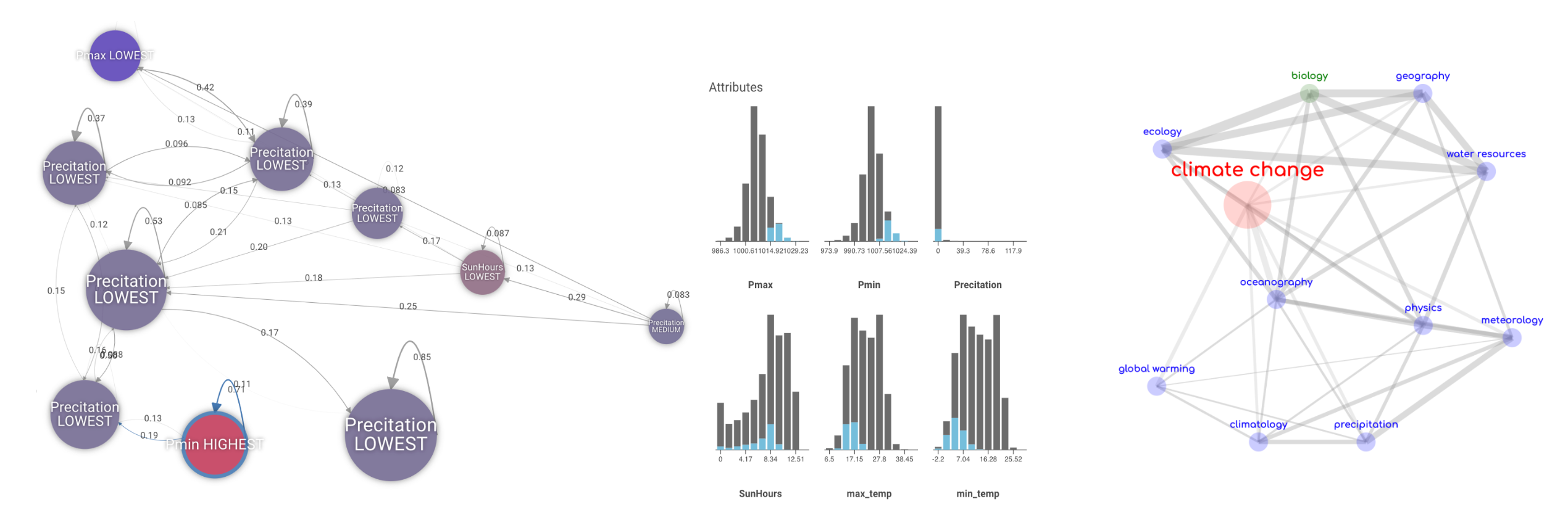Watering the Future: How AI is Reshaping the Way We Manage Our Most Precious Resource
Water is a vital resource essential for life and indispensable for many industrial and agricultural activities, determining one of the UN/s sustainable development goals being a priority for most governments worldwide. Preceding the UN Congress on Water we discuss how the management of water resources has become a critical concern, and AI and business intelligence have emerged as powerful tools for improving water management.

There is no doubt that water is a vital resource essential for life and indispensable for many industrial and agricultural activities. Due to factors such as population growth, climate change, and agricultural exploitation, water stress levels are being disturbed and water scarcity has become an increasingly pressing issue in many parts of the world. The phenomenon of climate change contributes to an increase in natural disasters such as hurricanes, tornadoes, floods, and droughts, as well as extreme weather conditions like heavy rainfall, melting glaciers, and rising sea levels. Therefore, it is crucial to understand the local impacts of climate change and take necessary steps to mitigate global warming and its potential consequences.The management of water resources has therefore become a critical concern, and artificial intelligence (AI) associated to business intelligence (BI) have emerged as powerful tools for improving "water intelligence" (WI). Preceding the UN Congress on Water we discuss how the management of water resources has become a critical concern, and AI and business intelligence have emerged as powerful tools for improving water management.
The combination of AI and BI can be particularly powerful for water management. For example, AI algorithms can be used to analyze data from sensors and other sources in real-time, and the resulting insights can be fed into BI tools to generate reports and visualizations that can be used by water managers and other stakeholders. This approach enables water managers to make data-driven decisions based on real-time information, resulting in more efficient and effective water management. AI and BI can also be used to improve the efficiency and reliability of water distribution systems. For example, AI algorithms can be used to analyze data from pressure sensors and other sources to detect leaks or other issues in water pipes. Similarly, BI tools can be used to track the performance of pumps, valves, and other components in water distribution systems and identify areas where maintenance or upgrades are needed.
In fact, also the knowledge extraction and representation using machine learning on text and engaging natural language processing (NLP) can derive best practices from similar cases identified worldwide, if we can go over the obstacle of absorbing the huge amount of published knowledge across many languages, released (and often public) in scientific articles and news articles. In this particular article, we give a particular focus to the innovative Water Observatory built in the context of the NAIADES project that we built to explore existing global information and business intelligence that can contribute to the global and local climate change resilience through AI.

The NAIADES Water Observatory (available online at naiades.ircai.org) has proven useful for understanding water-related topics such as extreme events, reclaimed water, and water contamination. By ingesting hundreds of thousands of news articles daily, the system can identify the main related concepts, automatically extract the impact of a water event in populations, and offer the perspective of media on governmental actions. And by text-mining more than 250 million scientific articles published worldwide, we can obtain the evolution of the topic of climate change over time and extract the main topics that relate to it (see figure above on the right), thus providing us with a better understanding of the context of the scientific community achievements. This understanding can help us find new solutions for the challenges of this new era.
This innovative European-based technology can also be used to address climate change preparedness from multiple angles. It utilizes mathematical models based on historical data to predict in the long run (10 years horizon) determinant parameters such as, e.g., river levels and water temperatures. The observatory analyzes over 20 years of daily environmental data, collected locally or over national open data portals, to identify trends and presents predictions as year-by-year averages. The Koopman approach is used to understand the non-linear dynamics of the dynamical system and the impact of climate change on air temperature and air pressure in the Spanish coastal city of Alicante, and water temperature and levels in the Swiss municipality of Carouge. To complement this, we have also used technology based on Markov chains to analyze specific water parameters in the 20 time series corresponding to 20 years of collected data and gain insight into seasonal changes over time, also taking into consideration sun hours and precipitation (see image above on the left).
We have been exploring these AI-driven capabilities and the user interaction with the interactive data visualisation that offers the insights, leveraging the feedback from presentations and consequent discussions, but also promoting the dialogue with climatology experts to better understand the conditionings to take into account to improve the long-term forecast of environmental trends and the impact that climate change has on these. Though, we know that this is a small drop on a sea of contributions that are being made and must engage the ICT community towards a sustainable future. How much do you think we can change things through the digital transformation of traditional methodologies and the appropriate use of AI capabilities? What initiatives do you know that are leading this change? Are you part of this global movement? Tell us about it.


توكيلات جلب الحبيب -𝟎𝟎𝟐𝟎𝟏𝟎𝟒𝟎𝟓𝟖𝟏𝟐𝟕𝟕- اكبر - شيخ روح
00201040581277- الحبيبجيب
جلب الحبيب
لجلب الحبيب
جلب الحبيب العنيد
جلب الحبيب بسرعة
دعاء جلب الحبيب
جلب الحبيب العنيد حظر
لجلب الحبيب
روحاني
دعاء جلب الحبيب كالمجنون مجرب
دعاء جلب الحبيب في 30 دقيقة
جلب الحبيبة
جلب الحبيب الى صورته بالجوال
جلب الحبيب في ساعة بالفاتحة
طريقة جلب الحبيب
سحر الجلب
جلب الحبيب بالملح
جلب الحبيب بسرعة
جلب الحبيب بالصورة
جلب حبيب عنيد
جلب الحبيب بصوره
جلب الحبيب بالقرآن
جلب حبيبان
جلب الحبيب بصورة
جلب الحب
جلب الحبيب بالملح
جلب حبيب للزواج
دعاء جلب الحبيبة
دعاء جلب الحبيب
دعاء جلب الحبيب
سحر للجلب
طلسم جلب الحبيب
جلب الحبيب في ساعة
جلب الحبيب عن طريق اسمه فقط
جلبت الحبيبة الحمراء مباشرة بك
جلب الحبيب العنيد بسرعة جدا جدا
جلب الحبيب الدفع بعد النتيجة
جلب الحبيب القران للتوعا ذليلا
ادعية لجلب الحبيب
جلب الحبيب القران الكريم خلال ساعة
جلب الحبيب في ساعة مجرب
جلب الحبيب العنيد مجانا
دعاء جلب الزوج في الساعة
جلب الزوج
تجارب البنات في جلب الحبيب
كيف جلب الحبيب
طلسم الحبيب خلال ساعة
دعاء جلب الزوج
جلب الزوج العنيد
طريقة جلب الحبيب من كتاب شمس المعارف
جلب الحبيب مجانا
دعاء الحبيب للزواج
جلب الحبيب للزواج بالقران مجرب
جلب الحبيب العنيد للزواج
جلب الحبيب العنيد بسرعة البرق
جلب المحبة
جلب الحبيب بالقران مجرب ومضمون النتيجة
سحر جلب الحبيب من كتاب شمس المعارف
دعاء لجلب الزوجة البرق بسرعة
عمل جلب الحبيب
طريقة جلب الحبيب بالقران
دعاء جلب الحبيب وقراره مباشرة
جلب الحبيب بسرعة مجرب
جلب الحبيب بسرعه
شيوخ جلب الحبيب
عمل لجلب الحبيب
جلب الحبيبة ياودود
تجربتي مع الحبيب
دعاء لجلب الزوج للفراش بسرعة البرق
دعاء جلب الحبيب العنيد
ادعية جلب الحبيب
جلب الحبيب والدفع بعد النتيجة
اقوى جلب للحبيب
جلب محبه وطاعه
جلب الحبيب بالفل الاسود
رد المطلقة بالملح
طرق لجلب الحبيب
جلب الحبيب بالسحر
جلب النساء للنكاح برقم الهاتف
دعاء لجلب الزوج العنيد
دعاء جلب الحبيب في ثانية واحدة
جلب الحبيب الدفع بعد النتيجة
جلب الحبيب من كتاب شمس المعارف
طرق جلب الحبيت بسرعة البرق
شيوخ لجلب الحبيب
ادعيه لجلب الحبيب
دعاء لجلب الحبيب للزواج
ماهو جلب الحبيب
آيات قرآنية لجلب الحبيب خلال ساعة
الوحي العجل لجلب الحبيب
دعاء لرجوع الحبيب سريعا
دعاء لرجوع الحبيب العنيد
جلب النساء
جلب الحبيب بسرعة البرق
سلبي الارادة والتهيج مجربة
طريقة لجلب الحبيب
كتاب شمس المعارف لجلب الحبيب
جلب الحبيب بالحلال
كيفيه جلب الحبيب
ماهو سحر جلب الحبيب
طلسم للمحبة والتهيج
الشيخ روحاني لجلب الحبيب
الشيخ روحاني ابو يونس المغربي
الشيخ روحاني ابو مهدي
الشيخ روحاني يونس المغربي
الشيخ روحاني سيبوزان
الشيخ روحاني ابو سليمان
شيخ روحاني لاستخراج الكنوز
الشيخ روحاني مغربي مجاني واتس اب
الشيخ روحاني عجائب وغرائب
الشيخ روحاني صادق
الشيخ روحاني جزائري
الشيخ روحاني قادر
الشيخ روحاني ابو سلمان
الشيخ روحاني مغربي الصادق والدفع بعد النتيجه
جلب الحبيب
جلب الحبيب بسرعة
جلب الحبيب العنيد بسرعة البرق
جلب الحبيب برقم الهاتف
جلب الحبيبة
جلب الحبيب ورق القرنفل
جلب الحبيب بالملح
جلب الحبيب بسرعة البرق
جلب الحبيب بالفلفل الحار يشعل النار في قلبه
جلب الحبيب بالصورة قوي جدا
جلب الحبيب للزواج سريعا مجرب وأكيد
جلب الحبيب بالملح خطير جدا
جلب الحبيب بالهاتف قوية جدا
جلب الحبيب بورقة سيدنا موسى
جلب الحبيب
جلب الحبيب
لجلب الحبيب
جلب الحبيب للزواج
جلب الحبيب العنيد
جلب الحبيب بسرعة
دعاء جلب الحبيب
جلب الحبيب العنيد حظر
لجلب الحبيب
دعاء جلب الحبيب كالمجنون مجرب
دعاء جلب الحبيب في 30 دقيقة
جلب الحبيبة
جلب الجلب الحبيب
جلب الحبيب
لجلب الحبيب
جلب الحبيب للزواج
جلب الحبيب العنيد
جلب الحبيب بسرعة
دعاء جلب الحبيب
جلب الحبيب العنيد حظر
لجلب الحبيب
دعاء جلب الحبيب كالمجنون مجرب
دعاء جلب الحبيب في 30 دقيقة
جلب الحبيبة
جلب الحبيب الى صورته بالجوال
جلب الحبيب في ساعة بالفاتحة
طريقة جلب الحبيب
سحر الجلب
جلب الحبيب بالملح
جلب الحبيب بسرعة
جلب الحبيب بالصورة
جلب حبيب عنيد
جلب الحبيب
.حبيب ينظر الى صورته بالجوال
جلب الحبيب في ساعة بالفاتحة
طريقة جلب الحبيب
سحر الجلب
جلب الحبيب بالملح
جلب الحبيب بسرعة
جلب الحبيب بالصورة
جلب حبيب عنيد
جلب الحبيب
.